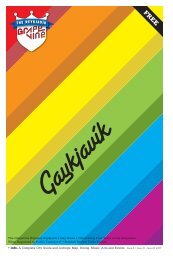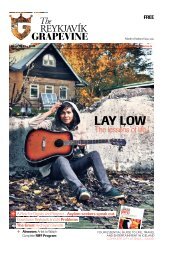7 august - The Reykjavik Grapevine
7 august - The Reykjavik Grapevine
7 august - The Reykjavik Grapevine
Create successful ePaper yourself
Turn your PDF publications into a flip-book with our unique Google optimized e-Paper software.
48<br />
<strong>The</strong> Violent<br />
Outburst of<br />
Graphic Design<br />
Liberal economist Thorvaldur<br />
Gylfason recently mentioned that<br />
once upon a time, and until quite<br />
late, history had been saturated with<br />
politics. Yes, from his words one<br />
could gather that history had once<br />
even been political history, pure and<br />
simple, whereas this would no longer<br />
be the case. What history consists<br />
of today, he did not mention,<br />
but certainly graphic design is a<br />
prominent candidate. One might<br />
even risk declaring the precise point<br />
where it, not so secretly, took over.<br />
At the beginning of the 20th<br />
century visuality entered a new era<br />
with the arrival of the camera. In a<br />
civilization founded on texts, where<br />
the rule of law has been the rule<br />
of the word, the arrival of direct<br />
visual testimony to the universe and<br />
habitat of humans was loud, even<br />
violent. <strong>The</strong> most violent response<br />
to the new visuality may be found in<br />
Nazism, which can, quite cynically,<br />
be seen as strictly centred on graphic<br />
design: to make humanity stylistically<br />
coherent.<br />
Of course, bringing Nazism up<br />
in any context is usually a rhetorical<br />
suicide. So this should be clarified<br />
and qualified a bit: things have<br />
been made to look this way or<br />
that way for a long time, for many<br />
different reasons, aesthetic or<br />
pragmatic. But it was only after the<br />
birth of the photocamera, and the<br />
subsequent birth of cinema, that<br />
propaganda on the scale of Nazi<br />
Germany became possible. And<br />
Nazi Germany is not merely the<br />
most infamous manipulator of those<br />
recent visual powers, but the first to<br />
employ visuals so fully for conscious<br />
mobilization and manipulation of<br />
people. What is more, the visual<br />
aspects of Nazism reached much<br />
further than propaganda, and can<br />
be interpreted as its aim: people and<br />
their habitat were supposed to fit an<br />
overall design concept.<br />
Adolf Hitler was stopped, as<br />
no graphic designer should be that<br />
powerful – and he was probably<br />
caught in an incoherent thought<br />
anyway: the main conclusion of the<br />
20th century might be that you don’t<br />
need to make the world fit an image,<br />
you can simply ignore the world<br />
and make an image fit the image.<br />
Subsequently, reality has now left the<br />
planet and landed in Photoshopland,<br />
possibly declaring the only actual<br />
winner of the wars of the 20th<br />
century: the poster.<br />
Graphic designers rule<br />
<strong>The</strong> influence of Nazi aesthetics<br />
on graphic design is no secret to<br />
graphic designers themselves, who<br />
generally look in awe at the immense<br />
coherence and sophistication of the<br />
work of Leni Riefenstahl and her<br />
coworkers. <strong>The</strong> principles of Nazi<br />
aesthetics are more easily applied<br />
to Iceland than many other places,<br />
and its influences can be found,<br />
quite clearly in many places. For<br />
example in advertisements for<br />
Icelandic museums that collectively<br />
invite visitors to realize the origins<br />
of Icelanders – showing blonde<br />
samples of, apparently half-naked<br />
natives, in sharp, sophisticated fullpage<br />
profiles. (Subsequently, foreign<br />
visitors have been known to call the<br />
museum tour the Eugenics Tour.)<br />
<strong>The</strong> designers. <strong>The</strong>y are no<br />
popstars, usually they are rather<br />
timid or shy creatures, often<br />
handsome, well-dressed or in any<br />
case stylistically conscious – but with<br />
Sassy colours<br />
and war<br />
images. What’s<br />
not to love?<br />
a slight grin on their faces. Because<br />
they know. <strong>The</strong>y might not brag<br />
about it, but they know it’s their<br />
world now.<br />
One pseudo-scientific way to<br />
check that statement is the Google<br />
test. “Grafískur hönnuður”, Icelandic<br />
for “graphic designer” gives around<br />
16,000 result pages. “Ljóðskáld” –<br />
poet – gives 850. That’s 20 mentions<br />
of graphic designers for every<br />
poet. “Myndlistarmaður” – visual<br />
artist – gives 3,600. “Blaðamaður”<br />
– journalist – does come close to<br />
the designers with 15,400, but even<br />
“Stjórnmálamaður” – politician – is<br />
far behind, at 4,170. “Nakin kona”<br />
– naked woman, only receives 194<br />
pages. I guess the outcome might be<br />
somewhat different in English, but<br />
as I want to keep my bias, I refuse<br />
to check. On Icelandic webpages,<br />
graphic designers are 800 times more










